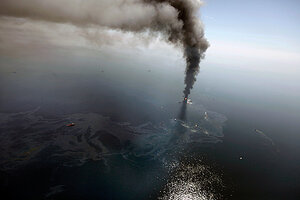Amid search for Deepwater Horizon oil rig survivors: What happened?
Despite the Deepwater Horizon oil rig's state-of-the-art equipment, drilling in the deep blue is still a roughneck's job – a combustible mix of big machines and highly flammable materials.

An oil slick is seen in the waters off Louisiana as the Deepwater Horizon oil rig burns on Wednesday.
Gerald Herbert/AP
Atlanta
The Transocean Deepwater Horizon oil rig is one of the most advanced engineering feats in the world, having drilled deeper than any other waterborne platform. But when the massive fifth-generation rig exploded late Tuesday night, injuring 17 workers and leaving 11 still missing, the accident proved even the most modern deepwater platforms are not immune to an age-old danger of tapping the earth: what roughnecks call, simply, blowout.
As Coast Guard planes and helicopters resumed the search for survivors Thursday morning, rescued rig hands arriving in Kenner, La., said that everything happened very fast. The Houston Chronicle quoted an unidentified survivor as saying, “It blew out and we had like zero time from the time the alarm went. It was all in flames.”
The Deepwater Horizon is on the cusp of global oil exploration, which is venturing ever further out to sea and deeper into the earth's crust.
IN PICTURES: Louisiana oil rig explosion
The rig is in essence a giant flexible drill bit that can poke and prod for deposits up to 32,000 feet deep. It is run by roughnecks, roustabouts, tool pushers, directional drillers, and mud men, all directed by a "company man," employed, in this case, by BP, which is leasing the rig from Geneva-based Transocean.
The semi-submersible rig had anchored 41 miles off Louisiana, completing a concrete casing for a well drilled to 18,000 feet in an area called the Macondo Prospect.
The company acknowledged that something happened in the hole, evidenced by the fact that the fire was being fueled by escaping oil or gas. “There was undoubtedly some abnormal pressure buildup,” Transocean safety director Adrian Rose said, according to Business Week. Rose gave no other clues about why the rig blew or why the pressure couldn't be controlled.
But former oil rig mud engineer Rusty Galloway in Lafayette, La., explains one possible cause. So-called mud hands on the drill floor mix chemicals into a stream of mud that backstops the gas or oil while allowing the bit to continue to turn its clockwise rotation into the earth.
"Basically, what can happen is you've got no weight or not enough weight to keep gas from coming out, from coming free," says Mr. Galloway.
The blowout theory surprised at least one industry expert. Rigs have complex safeguards to keep gas from escaping in case of an accident, including mechanisms that can physically shear the pipe to stop the flow.
"As soon as an incident takes place, a number of valves both underwater and on the rig will shut down the flow of hydrocarbons," says Jorge Pinon, former president of Amoco Latin America. "It's the same mechanism where if you hit a gas pump with your car, a valve will close the pipe that goes into the underground gasoline storage tank."
As the Coast Guard and the federal Minerals Management Service get ready to start an official investigation into the cause, survivors are hailing the response of the rig managers. Survivor Jim Ingram told the Times Picayune that weekly safety drills paid off as workers filed into life rafts that were lowered to the water.
"The standards out there are extremely high, when it comes to safety," said Mr. Ingram.
